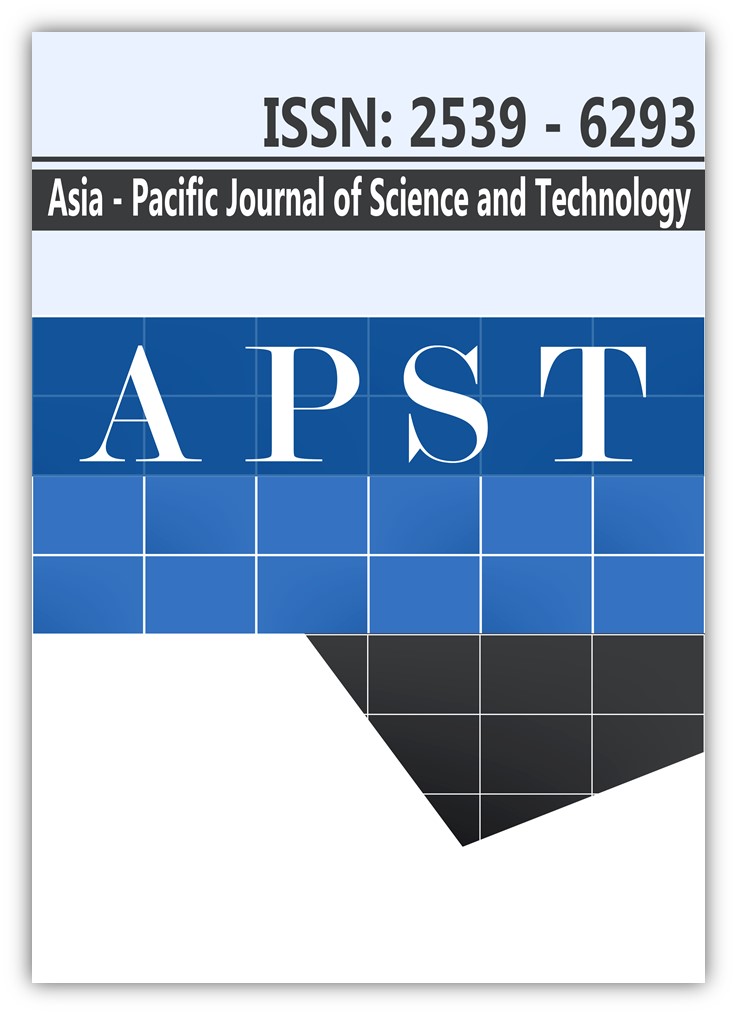Natural color extraction for painting
Main Article Content
Abstract
This study aimed to find the alternative choice which is apart from artificial color in creating artwork by comparing the colors of plants extracted by the different solvents and durability of colors from plants on various types of water colored paper between 200 gsm and 300 gsm. The plants were divided into three groups of the providing colors including red from roselle (Hibiscus sabdariffa L.) and sappan (Caesalpinia sappan L.), yellow from Coscinium fenestratum (Goetgh.) Colebr and the fruit of gardenia (Gardenia jasminoides J.Ellis) as well as blue from butterfly pea (Clitoria ternatea L.) and hom (Strobilanthes cusia (Nees) Kuntze) by the process of extraction with the solvents between water (H2O) and ethanol (C2H5OH) in ratio of 1:5 (plant: solvent). Then, painting these on two different type of paper is in order to comparing the durability of color including hue, saturation, and brightness by using the digital image colorimeter (DIC) in measuring the color value. The result revealed that the sappan provided the finest saturation and brightness on 300-gsm water colored paper in red group. Besides, the sappan extracted by water provides the finest saturation on the same type of paper. For yellow group, the gardenia fruit in ethanol solvent provide the finest saturation and brightness on 300-gsm water paper. Additionally, Coscinium fenestratum extracted by water (H2O) and ethanol (C2H5OH) provides the finest hue in equal on 200-gsm water paper. Lastly in blue group, butterfly pea in ethanol solvent provides the finest hue and brightness on 200-gsm water paper as well as hom provides the finest saturation on the in common paper. Finally, this study offers a method for selecting plants that provide accurate colors, and guide the process of color extraction for art that are suitable for future developments in painting materials.
Article Details
References
[2] Soonpongsri K. Aesthetics. Bangkok: Chulalongkorn University Press; 2012.
[3] Indranupakorn R. The screening and extraction of active constituents from the herbs. Bangkok: Chulalongkorn University Press; 2007.
[4] Chochai P. The study of cotton yams dyeing with dyes from yellow flamboyant bark. Area Based Dev Res J. 2011;3(6):84-92.
[5] Tuisakda P, Khamnuansin P. Traditional wisdom of natural cloth dyeing. Local Adm J. 2011;4(2):87-111.
[6] Nonsi C, Chinawong K. Pongkham Community Research Team. Conservation of traditional culture in cloth weaving and dyeing in Nan Province, Northern Thailand. Chiang Mai: Wanida Press; 2006.
[7] Srisukong A, Kanlayaporn J, Hanpakphum S. The study of antibacterial in weed extracts. VRU Res and Dev J Sci and Technol. 2016;11(1):69-82.
[8] Wongthanyakram J, Masawat P. Rapid low-cost determination of lead (II) in cassava by an iPod-based digital imaging colorimeter. Anal Lett. 2018;-:1-12.
[9] Masawat P, Harfield A, Namwong A. An iPhone-based digital image colorimeter for detecting tetracycline in milk. Food Chem. 2015;184:23-29.
[10] Discoveryplayground [Internet]. 2019[cited 2019 Jun 9] Available from: https://www.discoveryplayground. com/computer-programming-for-kids/rgb-colors/
[11] Kanchanarat S. Natural color tie-dye product kit for hobby. Silpakorn Univ J (Thai Edition). 2012;32(2):69-83.
[12] Silpakorn university. The 62nd National Exhibition of Art. Nonthaburi: Parbpim Printing; 2016.
[13] Yin Y, Jia J, Wang T, Wang C. Optimization of natural anthocyanin efficient extracting from purple sweet potato for silk fabric dyeing. J Clean Prod. 2017;149:673-679
[14] Avinc O, Celik A, Gedik G, Yavaş A. Natural dye extraction from waste barks of Turkish red pine (Pinus brutia Ten.) timber and eco-friendly natural dyeing of various textile fibers. Fiber Polym. 2013;14(5):866-873.


